Research News
- Dr Barman Decodes the Mysteries of the Universe September 25, 2024
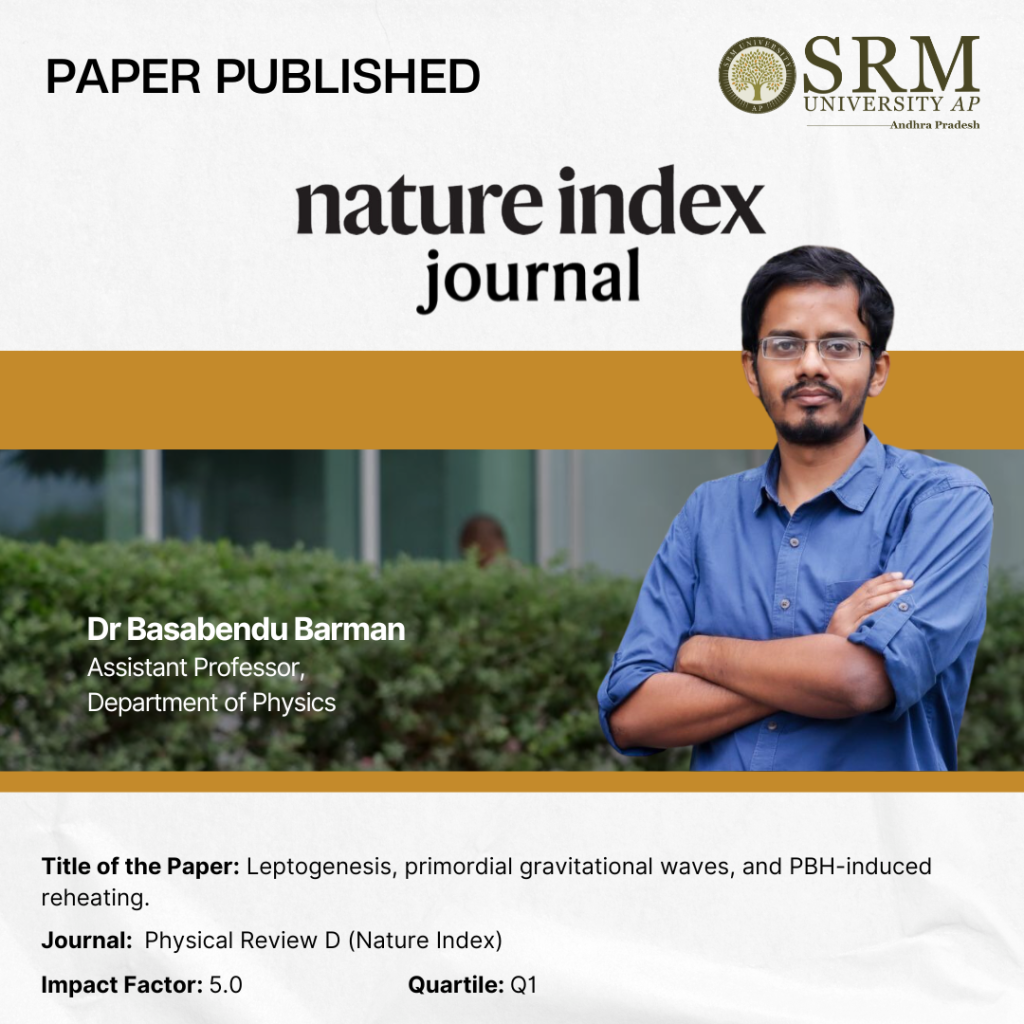
Ever wondered how the universe came into existence? The component with which matter and antimatter were formed? Dr Basabendu Barman, Assistant Professor at the Department of Physics, in his research paper, titled- Leptogenesis, Primordial Gravitational Waves, and PBH-induced Reheating delves into the truth of the formation of matter. Read this exciting paper featured in Physics Review D to learn more!
Abstract:
We explore the possibility of producing the observed matter-antimatter asymmetry of the Universe uniquely from the evaporation of primordial black holes (PBH) that are formed in an inflaton-dominated background. We show it is possible to obtain the desired baryon asymmetry via vanilla leptogenesis from evaporating PBHs of initial mass around 10g. We find that the allowed parameter space is heavily dependent on the shape of the inflaton potential during reheating, the energy density of PBHs, and the nature of the coupling between the inflaton and the Standard Model (SM). To complete the minimal gravitational framework, we also include in our analysis the gravitational leptogenesis set-up through inflaton scattering via exchange of graviton, which opens up an even larger window for PBH mass, depending on the background equation of state. We finally illustrate that such gravitational leptogenesis scenarios can be tested with upcoming gravitational wave (GW) detectors, courtesy of the blue-tilted primordial GW with inflationary origin, thus paving a way to probe a PBH-induced reheating together with leptogenesis.
Practical Implementations & Social Impact:
The first implication lies in the realm of intellect. The question, “Why is the Universe the way it is?” is profoundly significant and has likely intrigued humanity since the dawn of civilization. While technological advancements have allowed us to unravel many of the Universe’s mysteries, we have also come to realize that “what we know is a drop, and what we don’t know is an ocean.” As theoretical particle physicists, our role is to explore this vast ocean of the unknown—a pursuit for which we are rigorously trained. This underscores the vital importance of studying fundamental science. From a practical perspective, our study highlights the crucial role that experiments play in uncovering new knowledge. The synergy between theory and experiment, as we propose, could soon lead to groundbreaking discoveries—or, alternatively, our theory could be disproven if no evidence is found. Either way, it is essential to have advanced experimental facilities and more sensitive detectors to carry out these investigations. This, in turn, calls for increased funding and support for research in the field of high-energy physics.
Collaborations:
India (IIT: Guwahati, Kanpur, Hyderabad; IACS, Kolkata; IOP, Bhubaneswar).
Colombia (Universidad de Antioquia, Universidad de Santiago de Chile).
Abu Dhabi (New York University, Abu Dhabi).
Brazil (IIP, Natal).
Germany (Mainz Institute for Theoretical Physics [MITP], Mainz).
Poland (University of Warsaw).
Spain (Universidad Complutense,Madrid; IFIC, Valencia).
China (T D Lee Institute).
Korea (IBS, Daejeon; KIAS, Seoul; Kyungpook National University, Daegu).
Japan (Hokkaido Univeristy).
France (IJC Lab, Paris).
Sweden (KTH, Stockholm)
US (Washington University, St. Louis; University of Minnesota; Indiana University; University of Pittsburgh, University of Kentucky).Future Plans:
A closer look into early universe dynamics by performing more involved simulations.Connection between particle physics models and early Universe cosmology.Complementary searches from different experiments in unravelling new physics beyond the Standard Model.
Link: https://journals.aps.org/prd/abstract/10.1103/PhysRevD.110.043528
Continue reading →
- Dr Rupesh Kumar Secures Major Research Grant for Amazon Forest Canopy Mapping Project September 24, 2024
 In a groundbreaking development, Dr Rupesh Kumar, a Professor in the Department of Electronics and Communication Engineering, has been awarded a significant project titled “Mapping the Canopy of the Amazon Forest Using an Aerial Drone Platform Coupled with Radar Sensors.” The initiative, funded by the International Peruvian National Research Institute, boasts an impressive outlay of Rs. 1.11 Crores and is set to span over a two-year period.
In a groundbreaking development, Dr Rupesh Kumar, a Professor in the Department of Electronics and Communication Engineering, has been awarded a significant project titled “Mapping the Canopy of the Amazon Forest Using an Aerial Drone Platform Coupled with Radar Sensors.” The initiative, funded by the International Peruvian National Research Institute, boasts an impressive outlay of Rs. 1.11 Crores and is set to span over a two-year period.The project is spearheaded by Principal Investigator Dr Mark Donny Clemente Arenas, an Associate Professor at the National Technological University of South Lima in Peru. This collaboration aims to enhance the understanding of the Amazon’s intricate canopy structure and promote conservation efforts through innovative technology.
In recognition of this notable achievement, SRM University-AP proudly congratulated Dr Kumar and highlighted the significant impact this project could have on environmental research and sustainability. The university’s support underscores its commitment to fostering research initiatives that address global challenges, encouraging faculty members to pursue innovative solutions through collaboration and the application of cutting-edge technology.
This initiative marks a significant milestone in international research collaboration, leveraging technology to address critical environmental challenges in one of the world’s most vital ecosystems.
A Brief Description of the Project
This project facilitates the mapping of the Amazon forest in Peru. An integrated approach of advanced sensors such as LiDAR, Millimeter-Wave Radar, Camera, etc. and UAV will achieve this.
This will help assess the Amazon forest’s health in real time by leveraging the ML/AI approaches.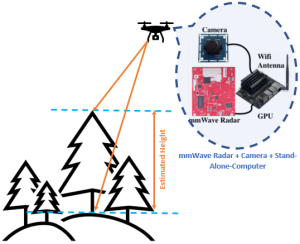
Figure 1: Scheme for height estimation
Explanation of the Research in Layperson’s Terms
The plant/tree generally reflects radio waves and other signals, and this reflection depends on the density of the forest. If a suitable signal processing is applied to the reflected signals, it will provide insight information about the forest profile. Nevertheless, this will help in the quantification of land covered by trees, identifying the location of those trees. Consequently, the tree canopy assessments help in determining the amount and location of impervious cover.
Funding Agency and Amount Sanctioned
National Scientific Research and Advanced Studies Program (PROCIENCIA) of the National Council for Science, Technology and Technological Innovation (CONCYTEC), Peru.
In Spanish: “ Programa Nacional de Investigación Cientifica y Estudios Avanzados (PROCIENCIA), del Consejo Nacional de Ciencia, Tecnología e Innovación
Tecnológica (CONCYTEC), Perú”.Practical Implementation of the Research or the Social Implications Associated with it
The proposed research work help will help in the assessment of deforestation as well as its impact on climate change and global warming. Not only this, but the research will also contribute to achieving carbon neutrality by 2050!
Collaborations
Universidad Nacional Tecnológica de Lima Sur
Collaborator: Prof. Mark Clement ArenasFuture Research Plans
In future, this work will be extended for infrastructure monitoring. With the boom in real estate, a continuous monitoring system is desired for proper maintenance.
Continue reading → - Dr Jaidev Kaushik’s Publishes New Publication on Graphene Incorporated Aerogels September 24, 2024
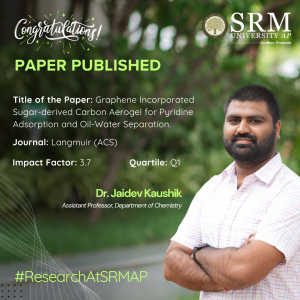 Dr Jaidev Kaushik, an Assistant Professor in the Department of Chemistry, has recently published a pioneering research paper in the prestigious journal Langmuir (ACS). The paper, titled “Graphene Incorporated Sugar-derived Carbon Aerogel for Pyridine Adsorption and Oil-Water Separation,” explores innovative applications of graphene-based materials.
Dr Jaidev Kaushik, an Assistant Professor in the Department of Chemistry, has recently published a pioneering research paper in the prestigious journal Langmuir (ACS). The paper, titled “Graphene Incorporated Sugar-derived Carbon Aerogel for Pyridine Adsorption and Oil-Water Separation,” explores innovative applications of graphene-based materials.Dr Kaushik’s research focuses on the development of a novel carbon aerogel derived from sugar and incorporated with graphene. This material demonstrates exceptional efficiency in adsorbing pyridine, a harmful organic compound, and effectively separating oil from water. These findings hold significant promise for environmental remediation and industrial applications, offering a sustainable solution to pollution and waste management challenges.
The publication of this paper in Langmuir highlights the cutting-edge research being conducted at SRM University-AP and underscores Dr Kaushik’s contributions to the field of chemistry. His work not only advances scientific understanding but also paves the way for practical applications that can benefit society at large.
Abstract
In this report, we have synthesized three-dimensional and hydrophobic graphene-incorporated carbon aerogel (G-SCA) derived from sugar. G-SCA is being used as a multifunctional sorbent material for removing various advanced water soluble and insoluble pollutants Initially, G-SCA is being explored for the adsorption of nitrophenols, nitroaromatics (3-nitroaniline), insecticide (Phoskill), antibiotic (ciprofloxacin), and pharmaceutical drug precursor (pyridine). Later, same G-SCA is also explored in the absorption of various protic and aprotic organic solvents and oils (including crude oil, waste cooking oil, and waste Mobil oil), with excellent recyclability checked up to 10 cycles. Moreover, oil-water separation experiments are also being done in various industrial wastewater samples and seawater to support the real-life accessibility of present approach. Large-scale applicability of G-SCA is also checked by performing crude oil-seawater separation experiments using a laboratory-scale prototype demonstrating the successful continuous recovery of crude oil.
Explanation of The Research in Layperson’s Terms
This research demonstrates the synthesis of carbon aerogel from edible sugar followed by the incorporation of graphene oxide to make a near superhydrophobic and good water-floating sorbent material. Later, this sorbent material was used to decontaminate wastewater from advanced pollutants such as explosive wastes, expired antibiotics, pharmaceutical waste, insecticides, etc. This report also showed the practical demonstration of crude oil recovery from seawater, thus contributing to the circular economy process.

Title of Research Paper in the Citation Format
F. Agrawal, K. Gupta, J. Kaushik, K. M. Tripathi, S. K. Choudhary, S. K. Sonkar, Graphene Incorporated Sugar Derived Carbon Aerogel for Pyridine Adsorption and Oil–Water Separation, Langmuir 2024, 40, 18028–18038.
Practical Implementation or the Social Implications Associated with the Research
This work describes the synthesis of low-cost near superhydrophobic carbon aerogel, displaying its multiple applications in wastewater treatment from water-soluble and water-insoluble pollutants. It is also an alternative and cost-effective approach for recovering valuable oil and organic compounds from water rather than degrading or destroying them so they can be reused.
Collaborations
Dr Sumit Kumar Sonkar (MNIT Jaipur, India)
Future Research Plans
1. The adsorption/photodegradation-assisted quick and efficient removal of next generation advanced pollutants such as microplastic, pesticides, pharmaceutical waste, etc. by hydrophobic carbon aerogel and their doped and functionalised versions.
Continue reading →
2. Utilizing waste derived heterogeneous catalysts in organic transformation reactions.
3. Selective sensing of toxic metal ions/biomarkers/biomolecules using fluorescent nanomaterials.
4. Upcycling of carbonates/CO2 via photo/thermal assisted reactions to get C1 and C2 hydrocarbons (green fuel). - Unveiling Innovations: Dr Ghosh Publishes Findings on 300 GHz Communication Links September 24, 2024
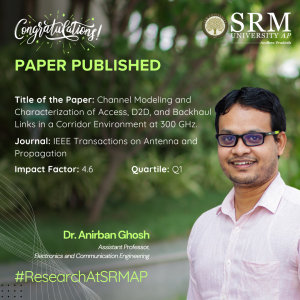 Dr Anirban Ghosh, an esteemed Assistant Professor in the Department of Electronics and Communication Engineering, has recently published a significant research paper titled “Channel Modeling and Characterization of Access, D2D, and Backhaul Links in a Corridor Environment at 300 GHz.” This paper has been featured in the prestigious Q1 Journal, IEEE Transactions on Antenna and Propagation, with an impressive impact factor of 4.6.
Dr Anirban Ghosh, an esteemed Assistant Professor in the Department of Electronics and Communication Engineering, has recently published a significant research paper titled “Channel Modeling and Characterization of Access, D2D, and Backhaul Links in a Corridor Environment at 300 GHz.” This paper has been featured in the prestigious Q1 Journal, IEEE Transactions on Antenna and Propagation, with an impressive impact factor of 4.6.
Dr Ghosh’s research delves into the intricate aspects of channel modelling and characterisation, focusing on access, device-to-device (D2D), and backhaul links within a corridor environment at a high frequency of 300 GHz. This study is poised to make substantial contributions to the field of wireless communication, particularly in enhancing the understanding and development of next-generation communication systems.
The publication in such a renowned journal underscores the quality and impact of Dr. Ghosh’s work, reflecting the cutting-edge research being conducted at SRM University – AP. The university community extends its heartfelt congratulations to Dr. Ghosh for this remarkable achievement and looks forward to his continued contributions to the field of electronics and communication engineering.Abstract:
This paper presents comprehensive double-directional channel measurements at 300 GHz across various corridor scenarios, including Access, Device-to-Device (D2D), and Backhaul, using an in-house developed channel sounder. The measurements, validated by ray tracing simulations, reveal that while 300 GHz quasi-optical propagation in corridors can be modeled using ray optics, non-trivial propagation phenomena, such as quadruple-bounce reflections, also occur. To accurately model these mechanisms, a quasi-deterministic (QD) channel model combining deterministic and random components is proposed. The QD model results align well with observations, highlighting similar propagation mechanisms for Access and D2D scenarios, while Backhaul scenarios show Line-of-Sight (LoS) impacts from ceiling reflections. These findings are crucial for designing next-generation THz communication systems.
Explanation of Research in Layperson’s Terms
This research contributes to building the next generation of communication networks, which will significantly impact society by improving connectivity, supporting technological advancements, and promoting economic development, and bringing forth several futuristic applications.
Practical Implementation
The results align with the design of high-frequency ultra-high speed, low-latency, reliable communication envisioned for several futuristic applications using beyond 5G and 6G networks.

The measurement scenarios explored in the paper.
Collaborations
Prof. Minseok Kim
Professor, Faculty of Engineering, Course of Electrical and Electronics Engineering
Niigata University, Japan.
e-mail: mskim@eng.niigata-u.ac.jpFuture Research Plans
The efforts would be extended to other communication scenarios for a similar study. Additionally, generating appropriate channel models, coverage design, link budget, etc for the explored and unexplored scenarios would also encompass an interesting study.
Continue reading → - Dr Nilakantha Meher’s Research Uses Light to Improve Object Detection Precision September 5, 2024
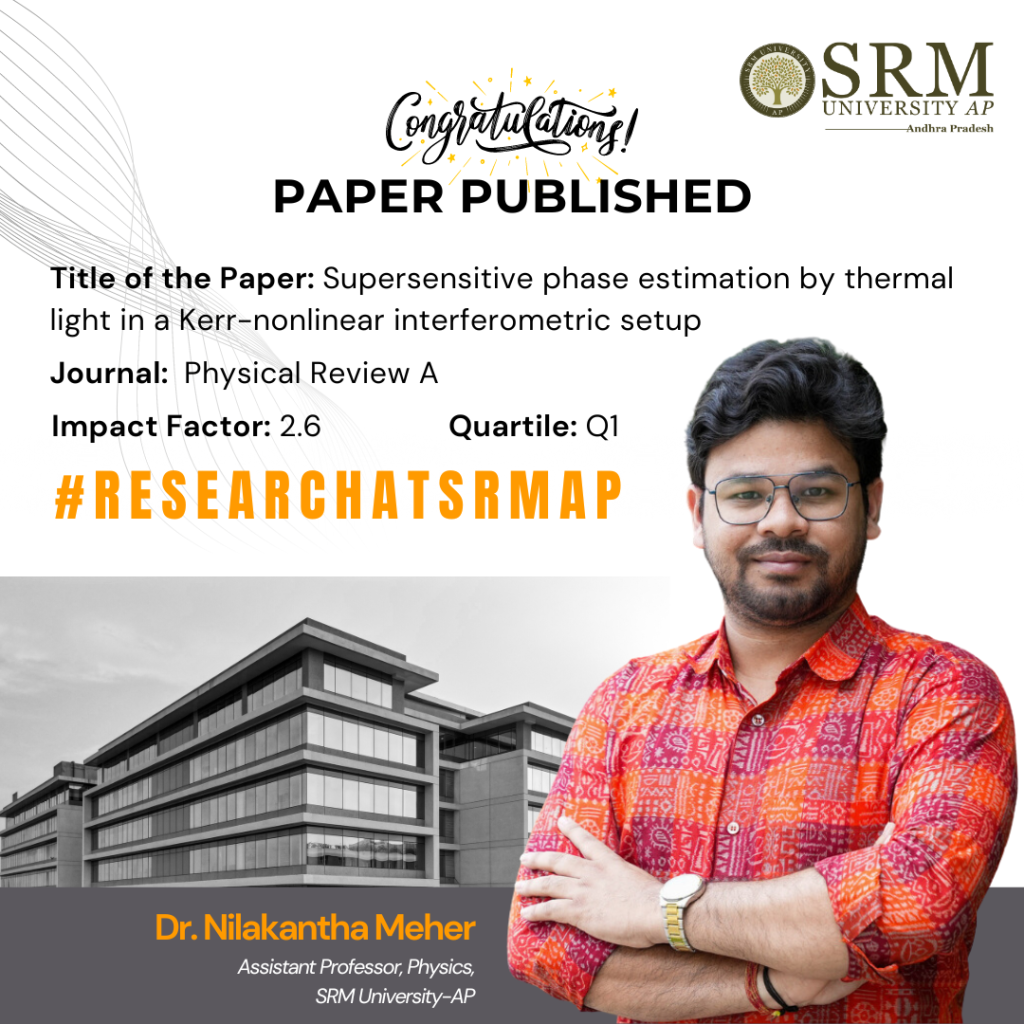
Dr Nilkantha Meher, an Assistant Professor in the Department of Physics at SRM University-AP, has significantly contributed to science with his research paper on using thermal light to detect objects with unmatched precision. This phenomenal work that featured in the journal Physical Review A will positively contribute to the fields of sensing, gravitational wave detection, and phase microscopy.
Abstract:
Estimation of the phase delay between interferometer arms is the core of transmission phase microscopy. Such phase estimation may exhibit an error below the standard quantum (shot-noise) limit, if the input is an entangled two-mode state, e.g., a N00N state. We show, by contrast, that such supersensitive phase estimation (SSPE) is achievable by incoherent, e.g., thermal, light that is injected into a Mach-Zehnder interferometer via a Kerr-nonlinear two-mode coupler. The phase error is shown to be reduced below, being the mean photon number, by thermal input in such interferometric setups, even for small nonlinear phase-shifts per photon pair or for significant photon loss. Remarkably, the phase accuracy achievable in such setups by thermal input surpasses that of coherent light with the same. Available mode couplers with giant Kerr nonlinearity that stems either from dipole-dipole interactions of Rydberg polaritons in cold atomic gas or from cavity-enhanced dispersive atom-field interactions may exploit such effects to substantially advance the interferometric phase microscopy using incoherent, faint light sources.
Practical Implementation:
The proposed nonlinear interferometer in this research can serve as a robust quantum sensor, making it suitable for a range of applications, including object sensing, gravitational wave detection, and phase microscopy.
Your Collaborations:
Prof. Gershon Kurizki (Weizmann Institute of Science, Israel)
Prof. Tomas Opatrny (Palacky University, Czech Republic)
Dr. Eilon Poem (Weizmann Institute of Science, Israel)
Prof. Ofer Firstenberg (Weizmann Institute of Science, Israel)Future Research Plans:
He is currently investigating the sensing of quantum entanglement and generating highly nonclassical states using various nonlinear interferometers. This research has significant implications for distributed quantum communication and quantum information processing.
Continue reading → - Paper on Deciphering Oxygen Evolution Reaction Activity: A QM/ML Approach with Single Atom Catalysts September 5, 2024

Prof. Ranjith Thapa in collaboration with two of his research scholars, Mr E. S. Erakulan Mr Sourav Ghosh and has come up with a groundbreaking research that has resulted in the publication of a scholarly paper titled, Specific Descriptor for Oxygen Evolution Reaction Activity on Single Atom Catalysts Using QM/ML.
Abstract of the paper
Descriptors are properties or parameters of a material that is used to explain any catalytic activity both computationally and experimentally. Such descriptors aid in designing the material’s property to obtain efficient catalyst. For transition metals, d-band center is a well-known descriptor that shows Sabatier type relation for several catalytic reactions. However, it fails to explain the activity when considering same metal active site with varying local environment. To address this, density functional theory was used for single atom catalysts (SACs) embedded on armchair and zigzag graphene nanoribbons (AGNR and ZGNR). By varying the anchoring nitrogen atoms’ orientation and considering pristine and doped cases, 432 active sites were used to test the oxygen evolution reaction (OER) activity. It was observed that S and SO2 dopant helps in reducing the overpotential on Co-SAC (h = 0.28 V). Along with the d-band center, a total of 105 possible descriptors were individually tested and failed to correlate with OER activity. Further, PCA was employed to narrow down unique descriptors and machine learning algorithms (MLR, RR, SVR, RFR, BRR, LASSO, KNR and XGR) were trained on the two obtained descriptors. Among the models, SVR and RFR model showed highest performance with R2 = 0.89 and 0.88 on test data. This work shows the necessity of a multi-descriptor approach to explain OER catalytic activity on SAC and the approach would help in identifying similar descriptors for other catalytic reactions as well.
Social Implications:
Computational studies have proven to be a vital tool to predict new materials and also assess the behaviour towards various catalytic reactions. They also identify the innate properties of the material which drives the catalytic activity. It helps in designing the material with required property to improve the catalytic activity. Descriptors are such computationally obtained properties/parameters of a material that has a meaningful relation with any catalytic property of a chemical reaction. d-band center, given by Hammer and Norskov in 1995, explained the binding strength of oxygen atom on pure transition metals. The d-band center shows Sabatier type relation with chemical activity and has been widely used to explain the catalytic activity of several reactions since its formulation. The adsorbate state after interaction with delocalized s-states of the metal atom is almost constant while that resulting from d-states interaction, is split into bonding and antibonding states. Hence the s-states were not considered. It is well known that, when the dimensions of a system are lowered the states become narrow and localized. In such systems, the d-band center does not explain the catalytic activity well and it is an open research problem.
Future Projects:
Density functional theory with machine learning approach could further be used and improved on similar SACs from which a predictive model equation could be constructed. Also, the proposed models are open to exploration on other catalytic reactions as well.
The authors thank SRM University-AP and National Super Computing mission for providing the computational facility.
Continue reading → - Enhancing Visual Saliency in Group Photographs: A Novel Approach for Improved Security and Healthcare Applications September 5, 2024

Dr Ravi Kant Kumar, an Assistant Professor at the Department of Computer Science and Engineering, and his research scholar, Ms Gayatri Dhara, have come up with a patent titled “A System and Method for Enhancement Of Visual Saliency Of Intended Face In Group Photography.” The patent, with Application Number 202441040020, employs pathbreaking technology to enhance security and healthcare applications, with real-time face recognition and remote diagnostics.
Abstract:
Visual saliency is a way of figuring out which parts of a scene draw our attention the most. When looking at a crowd or a group of faces, our eyes naturally focus more on certain faces than others. This happens because some faces have dominant features that stand out more. For faces that don’t naturally catch our attention, there is a need to make them more noticeable. This new method and system are designed to do just that. The system calculates scores based on various factors like skin tone, colour, contrast, position, and other visual details. These scores help identify which face needs enhancement, making it more prominent in a group of faces. The primary advantage of this invention is its potential to improve user experience in various applications, such as photo editing, social media, security systems, and more. By giving users, the control to select and enhance a specific face, it allows for a more personalised and targeted approach to face recognition and enhancement. This could be particularly beneficial in scenarios where the user wants to highlight a specific individual in a group photo or in a crowd. Overall, this invention represents a significant advancement in the field of face recognition and image enhancement, offering a novel and user-centric approach to visual saliency. It opens up new possibilities for user interaction and control in image editing and face recognition technology.
Practical and Social Implications
The practical implementation of this research lies in its ability to identify and enhance faces within a group or crowd that do not naturally draw attention. This innovative method and system address this issue by calculating saliency scores based on factors such as skin tone, colour, contrast, position, and other visual details. These scores are then used to identify faces that need enhancement to become more prominent in a group. The system’s ability to enhance specific faces has significant practical applications in several fields.
Photo Editing: Users can easily enhance specific individuals in group photos, ensuring that everyone stands out as desired. This is particularly useful for personal photos, event photography, and professional photo editing.
Social media: Enhanced face recognition and saliency can improve user experience by allowing users to highlight specific people in their posts, making photos more engaging and personalised.
Security Systems: In surveillance and security applications, the ability to enhance less prominent faces can improve the accuracy of face recognition systems, aiding in the identification of individuals in crowded or low-visibility conditions.
Collaborations:
SRM University-AP,
Dr Ravi Kant Kumar,
Mrs Gayathri Dhara.Future Research Plans:
Future plans for this visual saliency-based face enhancement system include refining algorithms for greater accuracy and efficiency, and integrating with popular photo editing software and social media platforms for seamless user experience. The technology will be expanded into security and healthcare applications, enhancing real-time face recognition and remote diagnostics. Emphasis will be placed on reducing biases, ensuring privacy protection, and enabling user customisation. Collaborations with academic institutions will drive further research, while commercialisation efforts will focus on launching products globally.
Continue reading → - Dr Negi’s Research Exploration of the Sugeno Exponential Function and Its Multidisciplinary Applications September 5, 2024

Dr Shekhar Singh Negi from the Department of Mathematics has published a research paper titled “A note on Sugeno exponential function with respect to distortion.” Dr Negi’s research investigates the Sugeno exponential function. This research develops new mathematical tools and rules to work with a different way of measuring things, which can be useful in various fields like economics, biology, or any area where traditional measurements don’t quite fit the problem at hand.
Abstract:
This study explores the Sugeno exponential function, which is the solution to a first order differential equation with respect to nonadditive measures, specifically distorted Lebesgue measures. We define k-distorted semigroup property of the Sugeno exponential function, introduce a new addition operation on a set of distortion functions, and discuss some related results. Furthermore, m-Bernoulli inequality, a more general inequality than the well-known Bernoulli inequality on the real line, is established for the Sugeno exponential function. Additionally, the above concept is extended to a system of differential equations with respect to the distorted Lebesgue measure which gives rise to the study of a matrix m-exponential function.
Finally, we present an appropriate m-distorted logarithm function and describe its behaviour when applied to various functions, such as the sum, product, quotient, etc., while maintaining basic algebraic structures. The results are illustrated throughout the paper with a variety of examples.
Collaborations:
Prof. Vicenc Torra, Professor at the Department of Computing Science at Umea University. His area of research include artificial intelligence, data privacy, approximate reasoning, and decision making.
Future Research Plans:
To explore the aforementioned derivative and investigate results with applications in real life.
Continue reading → - Research Paper on ESG Scores and Their Effect on Polluting Companies After COVID-19 September 5, 2024
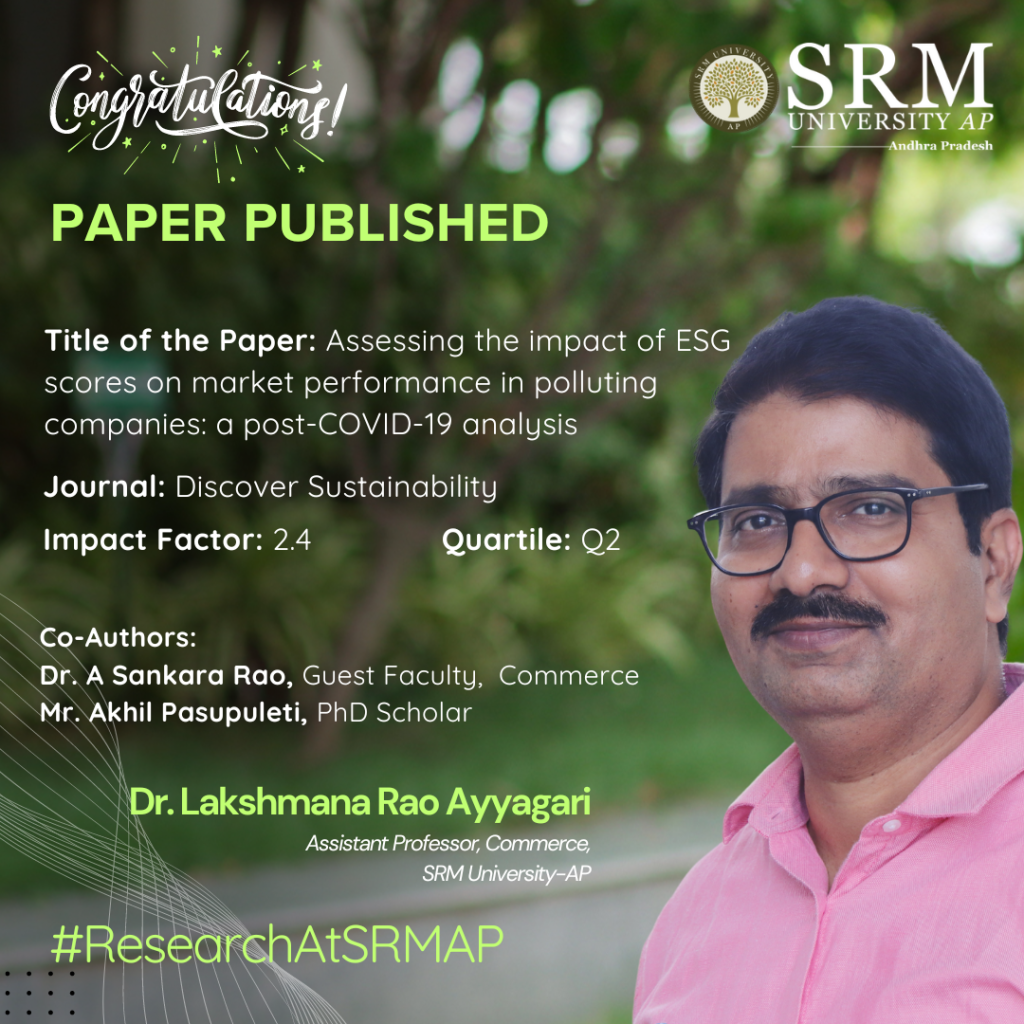
The Department of Commerce, under the Paari School of Business, is proud to present the research publication of Dr Lakshamana Rao Ayyangari, Guest Faculty Dr Sankar Rao, and Research Scholar Mr Akhil Pasupuleti. Their research paper, titled “Assessing the impact of ESG scores on market performance in polluting companies: a post-COVID-19 analysis,” is featured in the Q2 journal “Discover Sustainability.” Here is an interesting abstract of their research.
Abstract:
The study aims to unravel the impact of Environmental Social Governance (ESG) scores on the firm’s market performance of polluting companies. Moreover, the study also finds out the moderating effect of green initiatives. The study’s population consisted of 67 companies that were chosen from the list of polluting companies given by the Central Pollution Control Board of India for the post-COVID-19 timeframe of 2020–2023. The results indicate that the performance of ESG will improve the financial performance of the company.
Practical Implementation:
The analysis showed that companies with higher ESG scores generally perform better in the market. This means that firms that are more responsible in terms of environmental, social, and governance practices tend to do well financially. However, the study found that green initiatives did not have a significant impact on this relationship.
These findings are important for company managers and stakeholders. Understanding the connection between ESG practices and market performance can help managers create strategies to improve their ESG scores, ultimately boosting their financial performance.
Future Research Plans:
i) Focus on the R&D investment and sustainability.
ii) Studying the relationship between green finance and sustainability
iii) Exploring the relationship of CSR in sustainability
Continue reading → - Dr Mahesh Kumar Secures Patent for Advanced Data Generation Method August 28, 2024
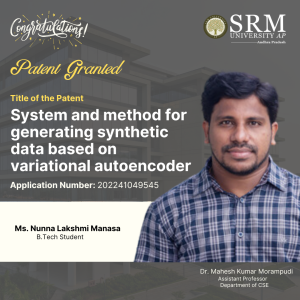 In a significant achievement for the Department of Computer Science and Engineering, Dr Mahesh Kumar Morampudi, Assistant Professor, along with B.Tech. student Ms. Nunna Lakshmi Manasa, has been granted a patent for their groundbreaking invention titled “System and method for generating synthetic data based on variational autoencoder.” The patent, with Application Number: 202241049545, was officially recognised in the Indian Patent Office.
In a significant achievement for the Department of Computer Science and Engineering, Dr Mahesh Kumar Morampudi, Assistant Professor, along with B.Tech. student Ms. Nunna Lakshmi Manasa, has been granted a patent for their groundbreaking invention titled “System and method for generating synthetic data based on variational autoencoder.” The patent, with Application Number: 202241049545, was officially recognised in the Indian Patent Office.This innovative system leverages the capabilities of variational autoencoders to generate synthetic data, which has vast applications in various fields, including machine learning, data privacy, and simulation. The ability to create high-quality synthetic datasets can significantly enhance research and development processes, providing researchers and practitioners with valuable tools for analysis and experimentation.
The recognition of this patent not only highlights the innovative spirit within the department but also underscores the collaborative efforts between faculty and students in advancing technology and contributing to the field of computer science.
Abstract of the Research
Diabetic retinopathy (DR) is a diabetes-related eye condition that occurs when high blood sugar levels cause damage to the blood vessels in the retina, the light-sensitive tissue at the back of the eye. Over time, these damaged vessels can leak blood or other fluids, leading to vision impairment.
DR typically progresses through stages, starting with mild non-proliferative retinopathy, where small bulges form in the blood vessels, to proliferative retinopathy, the most severe stage, where new abnormal blood vessels grow on the retina and in the vitreous humor, potentially leading to blindness. Early detection and management are crucial to prevent significant vision loss, often involving regular eye exams, blood sugar control, and treatments like laser therapy or surgery.

Synthetic data generation for DR is an emerging approach to augment limited clinical datasets, enhancing the training of machine learning models for diagnosis and prognosis. The present disclosure envisages a system for generating synthetic data based on a variational autoencoder (VAE). This work explores the use of a VAE combined with deep learning for the detection and classification of DR. VAEs, known for their ability to learn compact and meaningful representations of complex data, are employed to generate latent features from retinal images, effectively capturing the subtle variations and anomalies indicative of DR. These latent features are then fed into a deep learning classifier, which is trained to categorise the severity of DR into various stages, ranging from no DR to proliferative DR.
Research in Layperson’s Terms
Imagine your eye is like a camera, and the retina at the back of your eye is the film that captures the pictures you see. DR is a condition that affects this “film” when someone has diabetes for a long time. High blood sugar levels can damage the tiny blood vessels in the retina, leading to vision problems and, in severe cases, blindness.

Our research is about creating a computer program that can help doctors detect and classify this eye condition more accurately. We use a special kind of technology called a VAE, which is like a smart artist that learns to understand and recreate detailed images of the retina. This “artist” can pick up on the tiny changes and patterns in the retina that might be missed by the human eye. Once the VAE has learned these details, it passes them on to another program, which is really good at sorting things into categories. This second program, a deep learning classifier, uses the information from the VAE to decide how severe diabetic retinopathy is—whether it’s mild, moderate, or severe.
By combining these two technologies, our system can help doctors detect diabetic retinopathy earlier and more accurately, which is crucial for preventing vision loss in people with diabetes.
Title of the Patent in the Citation Format
Inventor Name(s):
Dr Mahesh Kumar Morampudi
Nunna Lakshmi Manasa
“System and method for generating synthetic data based on variational auto encoder” with Application Number: ” 202241049545.” Date of Patent Grant. 29/07/2024Practical Implementation:
The practical implementation of our research involves integrating the VAE and deep learning classifier into a software tool that can be used by eye care professionals. Here’s how it might work in a real-world setting:- Data Collection: Retinal images are collected from patients during routine eye exams. These images are fed into the system, which has been trained using a large dataset of retinal images, including those showing different stages of DR.
- Feature Extraction: The VAE processes these images, learning to capture and condense the important features that indicate the presence and severity of DR. This step is crucial because it allows the system to focus on the subtle details that might signify early stages of the disease.
- Classification: The deep learning classifier then takes these features and classifies the severity of DR. It provides a diagnosis, categorising the condition as no DR, mild, moderate, or severe. The system could also flag cases that need urgent attention, helping prioritise patient care.
- Clinical Decision Support: The results are presented to the healthcare provider through an intuitive interface. This tool could be used in clinics, especially in areas with limited access to specialised eye care, allowing general practitioners or technicians to screen for DR and refer patients for further treatment if needed.
Social Implications:
- Increased Access to Early Detection: By automating the detection of diabetic retinopathy, this technology can be deployed in remote or underserved areas where access to specialists is limited. Early detection is key to preventing vision loss, and this tool can make screening more accessible, especially in communities with high rates of diabetes.
- Reduced Healthcare Costs: Early detection and treatment of diabetic retinopathy can prevent the progression to more severe stages, reducing the need for expensive treatments like surgery or long-term care for blindness. This could lower healthcare costs for both patients and the healthcare system.
- Empowering Healthcare Providers: The tool can support general healthcare providers in making more accurate diagnoses, reducing the burden on specialists and allowing them to focus on more complex cases. This democratizes eye care, making it possible for more people to get the care they need without long delays.
- Improved Patient Outcomes: With more accurate and timely diagnosis, patients can receive treatment sooner, leading to better health outcomes and preserving vision. This can significantly enhance the quality of life for individuals with diabetes, who might otherwise suffer from preventable blindness.
- Ethical Considerations: While technology offers many benefits, it also raises ethical questions about the use of AI in healthcare, such as ensuring that the system is fair, transparent, and does not introduce biases. Continuous monitoring and updates would be necessary to ensure the system remains accurate and equitable.
Future Research Plans
- Improving Model Robustness and Generalization: Enhance the VAE and deep learning classifier’s ability to generalize across diverse populations and imaging conditions.
- Incorporating Multimodal Data: Integrate additional data sources, such as patient medical history, blood sugar levels, and genetic information, to improve diagnostic accuracy.
- Real-Time Implementation and Mobile Integration: Adapt the system for real-time analysis and deploy it on mobile devices.
- Collaboration with Clinical Trials: Validate the AI system’s effectiveness through collaboration with clinical trials.

